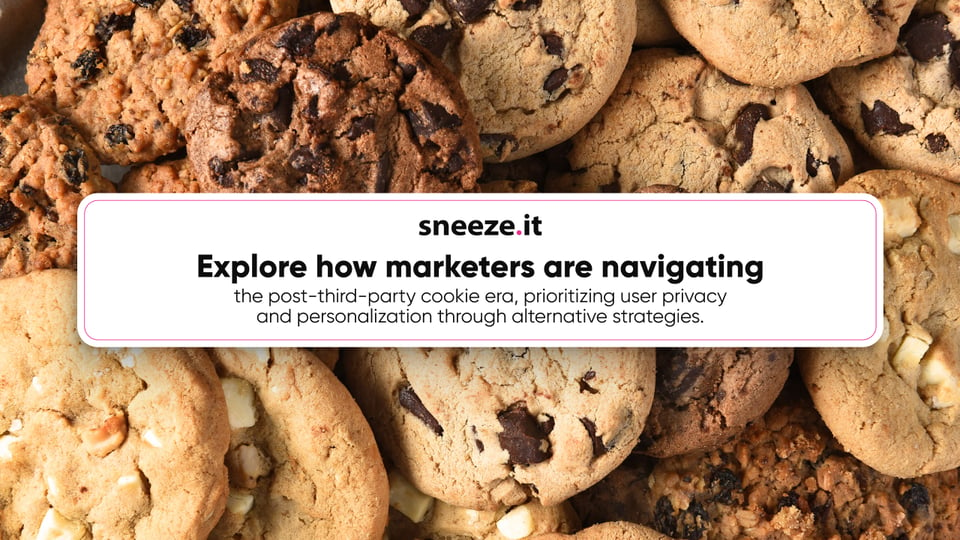In marketing, the ultimate goal is to convert potential customers into paying customers. To achieve...
What does Marketing Look Like Without Third-Party Cookies?

Explore the challenges and opportunities marketers face in the absence of third-party cookies, and learn some helpful tips for navigating the new era of privacy-focused marketing.
In the digital marketing landscape, third-party cookies have long been an integral part of tracking user behavior and targeting ads. However, with increasing concerns about privacy and the phasing out of third-party cookies by major web browsers, marketers are now faced with the challenge of rethinking their strategies. In this article, we will explore what marketing looks like without third-party cookies and discuss alternative approaches that can help businesses thrive in this new era of privacy-focused marketing.
The Evolution of Third-Party Cookies
Third-party cookies are small text files that are placed on a user's computer when they visit a website. These cookies track their online activities across multiple sites, providing marketers with valuable insights into user behavior and enabling personalized advertising. However, concerns about privacy and data security have led to a shift in the digital landscape.
The Changing Privacy Landscape
In recent years, privacy regulations such as the General Data Protection Regulation (GDPR) and the California Consumer Privacy Act (CCPA) have brought data protection and user privacy to the forefront. Additionally, major web browsers like Google Chrome, Safari, and Mozilla Firefox have announced plans to phase out support for third-party cookies. These developments have significant implications for marketers who rely heavily on third-party data for targeting and retargeting.
The Impact on Targeted Advertising
Without third-party cookies, marketers face challenges in delivering targeted advertising. They can no longer rely on cookie-based tracking to follow users across the web and deliver personalized messages. As a result, marketers need to explore alternative methods to reach their target audience effectively.
First-Party Data: The New Marketing Currency
In the absence of third-party cookies, first-party data becomes crucial for marketers. First-party data refers to information collected directly from users who have interacted with a brand's owned properties, such as websites, mobile apps, or email newsletters. By leveraging first-party data, marketers can build direct relationships with their audience and deliver personalized experiences without relying on third-party cookies.
Building Trust and Transparency
To succeed in the post-third-party cookie era, marketers must prioritize building trust and transparency with their audience. Users are becoming more aware of their data rights and are actively seeking greater control over their online experiences. Marketers should clearly communicate their data collection and usage practices and offer users transparent options to control their data.
Contextual Targeting: Focus on Content
Contextual targeting is another approach that marketers can adopt to overcome the limitations of third-party cookies. Instead of relying on individual user data, contextual targeting considers the content and context of the web page where an ad is displayed. By aligning ads with relevant content, marketers can reach audiences based on their immediate interests and the context of their online activities.
Collaboration and Partnerships
In the absence of third-party cookies, collaboration and partnerships become essential for marketers. Brands can work closely with publishers and other trusted partners to access their first-party data and create mutually beneficial relationships. This data collaboration allows marketers to tap into larger audiences while maintaining user privacy and adhering to data protection regulations.
Investing in Advanced Technologies
Technological advancements, such as artificial intelligence (AI) and machine learning, can play a significant role in enabling effective marketing without third-party cookies. AI-powered algorithms can analyze vast amounts of data, including first-party data and contextual signals, to derive valuable insights and deliver personalized experiences to users.
The phasing out of third-party cookies is transforming the digital marketing landscape. Marketers need to adapt their strategies to prioritize user privacy, build trust, and leverage alternative approaches to targeting and personalization. By focusing on first-party data, contextual targeting, collaboration, and advanced technologies, businesses can navigate this new era of privacy-focused marketing successfully. Embracing these changes will not only help marketers stay compliant with evolving regulations but also foster stronger relationships with their audience and deliver more relevant and engaging experiences.
Want to learn how Sneeze it can help you elevate your marketing and take your business to the next level? Schedule a meeting with our sales team below!





